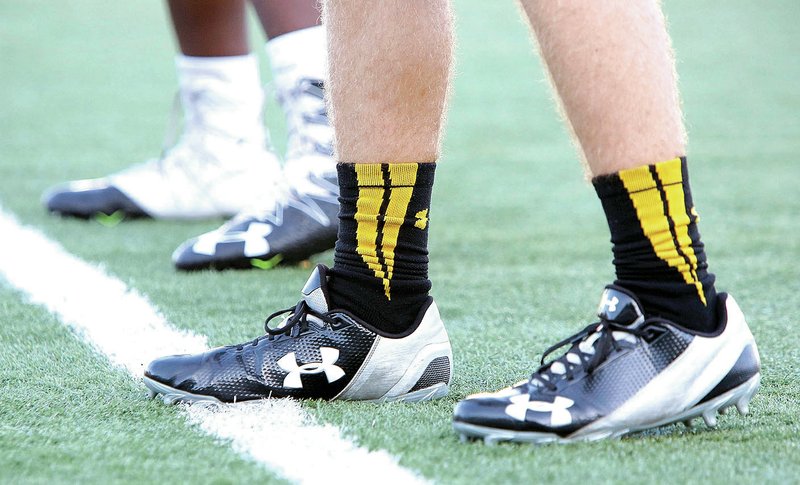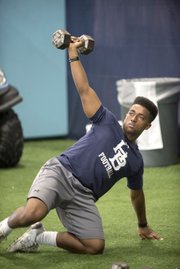Rogers High School athletic teams dropped their bill for uniforms this year by an estimated $41,000 thanks to sports apparel maker Under Armour.
The Springdale and Fayetteville districts also receive shoes and apparel at reduced prices at Northwest Arkansas sporting goods stores. Bentonville doesn't have a districtwide or school-based contract, but each athletic program in the district is free to seek its own apparel deals, said Scott Passmore, Bentonville athletic director.
Sports apparel sponsorships
7A-West Conference (prior to 2016-18 cycle)
School/District^Apparel contract^Contract terms
Bentonville^No district contract (Teams can seek their own apparel deals)
Fayetteville^Under Armour^3 years, $7,000 per year (plus discounted apparel)
Fort Smith School District^No district contract (Northside girls basketball only team in district with apparel deal)
Rogers School District^Under Armour^3 years, $10,000 per year (plus discounted apparel)
Springdale Har-Ber^Under Armour^3 years, $5,000 per year (plus discounted apparel)
Springdale High^Adidas^3 years, $5,000 per year (plus discounted apparel)
Source: Staff report
Online video
For related video, go to www.nwadg.com.
This trend won't slow down any time soon with all major apparel companies showing increased interest, said Mark Holderbaum, Rogers School District athletic director.
"I know that Under Armour and Adidas are making an aggressive push to climb the ranks," he said. "They've really been aggressive about getting into that high school market."
Oregon-based Nike has been the leader in the apparel and shoe game, but companies such as Under Armour, which started in 1996, and Adidas have followed in recent years.
"We currently have hundreds of high schools on our roster," Ryan Kuehl, Under Armour vice president of sports marketing, told the Baltimore Sun. "Our brand awareness is much greater on the East Coast, given our corporate headquarters location in Baltimore, but our brand is growing rapidly across the globe, and our business categories at every level are following suit."
Mike Blackburn is executive director of the National Interscholastic Athletic Administrators Association. The association is a nonprofit group in Indianapolis with 9,000 members across the country. The most interesting aspect of the trend is the sheer scale of it, he said.
"There are 20,000 high schools in the United States, so there's a lot of room for this to keep growing, and it's even reaching into middle schools now," he said.
Today's high school athletes want to play well, but they also want to look good doing it.
"I think it's a pretty big deal to be one of the schools to be wearing Under Armour," said Taylor Powell, Fayetteville quarterback. "It shows what they think of our program, and I honestly think our uniforms are the best in the state."
Powell, who this summer committed to play college football at Wake Forest, noticed during his recruitment what the university had to offer in the latest Nike uniform combinations.
"I feel like over the years, the kids being recruited have paid more attention to the uniforms," Powell said. "I'm not going to lie, I looked into that, but that's not what the final decision is about.
"I would never come to a point where I was making a decision based on uniforms. But I know some players do choose some schools because of that."
Here's The Deal
Rogers' contract gives the district 35 percent off Under Armour uniforms and 30 percent off apparel and shoes. The district also receives an annual allotment used to purchase Under Armour apparel.
Under Armour provides $10,000 per contract year, plus $2,000 for an additional athletic director account, with money used on uniforms, shoes, practice gear and T-shirts for all athletic teams at Rogers and Heritage high schools and the middle schools.
The annual uniform expense for the Rogers district is $95,000, according to Holderbaum. When the 35 percent discount for Under Armour apparel and the $12,000 received annually under the contract is applied, the total spent by the district drops to about $53,950.
"You can see how it increases our buying power," Holderbaum said. "Plus, prior to this many of our teams were buying lesser known brands. Now with the discount guarantee, all of our teams can buy the name brand and be standardized across the district," he said.
The Fayetteville School District has a similar contract with Under Armour for $7,000 per year while also including a 40 percent discount on Under Armour apparel purchases.
The Springdale School District has two contracts, a three-year deal with Under Armour for $5,000 and discounted apparel at Har-Ber High School, and another three-year contract for the same amount for Springdale High School with Adidas.
Sports sponsorships in the region are primarily reserved for the largest schools. Siloam Springs, Alma and Greenwood don't have exclusive sports sponsorships, for example.
Preps And Below
The market for sponsorships at the high school level is relatively new, especially in Arkansas. Some schools had single-team deals for basketball uniforms and shoes or football jerseys.
A handful of football teams in the area, beginning with Fayetteville, Har-Ber and Shiloh Christian School in Springdale, signed with Under Armour beginning in 2008.
Holderbaum signed the first districtwide contract for a high school team in Northwest Arkansas in 2014.
He looked into how college athletic programs handled apparel sponsorships, then contacted four companies: Adidas, Nike, Russell and Under Armour. All but Nike responded with an offer.
Rogers signed a three-year, district deal with Under Armour.
"Basically it has worked out really well," Holderbaum said. "Because now we have a much better buying power."
Not every sport has an available Under Armour uniform.
"Under Armour just added wrestling, and they still don't have swimming," Holderbaum said. "But they're still adding more sports and continuing to grow."
The trendsetter in the 7A-West Conference was Rickey Smith and his Fort Smith Northside High School girls' basketball team. The Lady Bears for many years were the only team in the conference to have an apparel sponsorship.
Nike approached Smith after the Lady Bears won their second consecutive state championship in Arkansas' largest class in 2000. Northside was among the elite eight high school girls teams across the nation to receive a contract from Nike at the time.
The Lady Bears are still exclusively with Nike, the world's largest revenue producing apparel and shoe company with the familiar "swoosh" logo. It supplies the team with free shoes, gym bags, warm-ups, socks, polo shirts for the coaches and basketballs.
"Every October, our kids can't wait for that shipment from FedEx to arrive because they know there's going to be some Nike gear in the boxes," said Smith, whose teams won four state championships from 1999-2002. "It's a special day for the team."
The Northside girls are the only team in the Fort Smith School District to have a sports apparel sponsorship. The boys teams at Northside and the teams at crosstown Southside High School don't, said Darren McKinney, athletic director.
Magic of Branding
Lucy Brown, assistant clinical professor in advertising at the University of Arkansas, noted several reasons for the trend to younger teams.
"From a marketing-brand relationship, it's their target demographic," Brown said of the sports apparel companies. "Young people set the trends."
Brand loyalty established in teen years tends to stick, she said, such as the music people listen to as teens is the music they generally prefer for the rest of their lives.
The marketing works by establishing a positive emotional connection for the athletes who want to wear the jerseys and make the team.
"That boosts your ego," she said.
The nonathletes adopt the style so they can be associated with the "cool" students, she said.
Young people today also tend to reject traditional advertising, Brown said.
"Brands are looking for an opportunity where they are not doing a hard sale," she said. The sponsorships are more longterm, not fleeting like a television commercial, she said.
Apparel companies also want parents and fans to wear their brands, said Blackburn with the athletic association.
"The thing I've noticed is that it's the buying power of the community, not as much the strength of the program, that seems to lead to sponsorship," he said.
A school drawing a large, affluent crowd to a stadium regularly seems to have a better chance of attracting a sponsorship than a small team in a poorer community winning more games, he said.
No school has complained to him of being taken advantage of or not having the contract terms fulfilled by a sponsor, he added.
A University of Arkansas business student published a paper on the trend in 2012, emailing survey questions to both athletic directors and school administrators at high schools in Arkansas and Oklahoma. Of the 58 who responded, only one said he thought corporate sponsorship was inappropriate.
This trend won't slow down any time soon with all major apparel companies showing increased interest, Holderbaum said.
"I know that Under Armour and Adidas are making an aggressive push to climb the ranks," he said. "They've really been aggressive about getting into that high school market.
"High school coaches and athletic directors, a lot of time we see what they're doing in college and we try to bring that to the high school level," he said. "The money might not be the same, but we're still trying to get the best deal for our schools."
NW News on 08/15/2016

